
Stephen Welsh and Michelle Hippolite, Kaihautü at the Museum of New Zealand Te Papa Tongarewa at the time, engaging in the hongi after the repatriation of Māori ancestral human remains in 2008. Photo by Stephen Devine
After almost two years working on the creation of the International Slavery Museum in Liverpool, I turned up at Manchester Museum in May 2007 to be interviewed for the post of curator of the living cultures collection. (What’s a living cultures collection, I hear you ask? I’ll get to that shortly.) I was only 26, nervous as hell, and wet behind the ears. I faced a formidable panel comprised of two deputy directors, an archaeology curator and a professor of social anthropology. I was frozen to the spot as they grilled me about the ins and outs of caring for a university museum collection consisting of 18,000 objects from Africa, the Americas, Asia and the Pacific. Petrified, I started to zone out – that’s until one of the deputy directors asked me to define what curatorship is. I’d spent the previous 24 hours anticipating possible questions but this one hadn’t occurred to me. Instinctively I compared it with social work.
Intrigued, the deputy director asked me to explain what I meant. Why hadn’t I simply defined it as managing a database or creating displays or writing labels? These would’ve been perfectly satisfactory responses but they didn’t fully express my experience as a rookie curator up until this point. During my time at the International Slavery Museum I’d encountered complex combinations of objects, people, and emotions, all intimately connected with enslavement, racism, and violence. This work required empathy, solidarity, and an ability to build trust with individuals, families, and communities – attributes that social workers have in droves. This was possibly the most unconventional definition they’d heard all day. That being said, I got the job. Back then museums were prepared to take risks.
So, what is a living cultures collection? It used to be called the ethnology collection but the museum renamed it shortly before I arrived. It was constructed in the late 19th century, like many others of the same type in the UK and globally, and mostly consists of objects belonging to peoples who were colonised by the British. Colonialism facilitated the removal of vast quantities of cultural heritage and ancestral human remains from countries of origin, source communities, and Indigenous peoples. Once deposited in museums, these dislocated objects and ancestors were misunderstood, misinterpreted, and used to support theories of white superiority, cultural evolution, and vanishing peoples. Given this origin, a name change may seem like a cynical PR stunt, but it was more profound than that. Contrary to popular Victorian theories, the ethnology collection had never stopped belonging to living cultures.
Words are all very good but what about deeds? You can’t change Victorian curatorial orthodoxies with a shift in nomenclature alone. After centuries of Indigenous resistance, Manchester Museum began repatriating ancestral human remains to Australia, Aotearoa, and Rēkohu from 2003 onwards. But what about objects? Cue an email from the Australian Institute of Aboriginal and Torres Strait Islander Studies (AIATSIS) in early 2019. In partnership with Australia’s First Nations Peoples AIATSIS had identified 43 secret sacred and ceremonial objects they wanted to discuss. This was part of their Return of Cultural Heritage Project and they wanted to explore the possibility of a return. After innumerable conference calls, an intense period of research and relationship building, and bonding over a mutual appreciation for a certain brand of trainers, we secured an unconditional repatriation.
These objects were returning home, not to another museum in Australia, but directly to the Aranda people of Central Australia, Gangalidda Garawa peoples of northwest Queensland, Nyamal people of the Pilbara, and Yawuru people of Broome. On a cold Manchester morning in November 2019 the AIATSIS team and Gangalidda Garawa men Mangubadijarri Yanner and Donald Bob arrived at the museum. After traveling for several days from Moungibi, and having been separated from their peoples for over a century, Traditional Owners Mangubadijarri and Donald spent time alone with their objects.
When all the interviews, transport preparations, and sampling the best pies in Manchester were over, we had some time to reflect. In a museum storeroom Mangubadijarri asked each of us what our connection with the project was. I could’ve just said that it’s my job, which is true, but it didn’t fully express my experience as a socially conscious curator up until this point. During my time at Manchester Museum I had, once again, encountered complex combinations of objects, people, and emotions, all intimately connected with colonialism, oppression, and cultural expression. This project also required empathy, solidarity, and an ability to build trust. That’s why I was connected.
As a gay working class man I never imagined that I’d be a university museum curator, but for the past 13 years that’s exactly what I was. From the very outset I was determined to deconstruct Victorian curatorial orthodoxies, and embed a socially conscious and engaged practice. It wasn’t always easy or popular, and I couldn’t have done it without the encouragement, guidance, and friendship of those individuals, families, and communities most intimately connected with the collection.
It’s been a process of atonement, decolonisation, and reconciliation, culminating in the unconditional repatriation of cultural heritage to Australia’s First Nations peoples. But it doesn’t stop here. Now, as an independent curator I’m equally as passionate about this work as the 26 years old rookie was. Deep down it’s all about how we get along.
But above all, there is harmony.
Because we got to listen to one another.
– Jurassic 5 ‘How We Get Along’
Filed under: Art & Photography
Tagged with: AIATSIS, Australia, collections, colonialism, community, curator, curatorial practice, indigenous, living cultures, museum, repatriation, slavery, socially engaged, trust



Comments